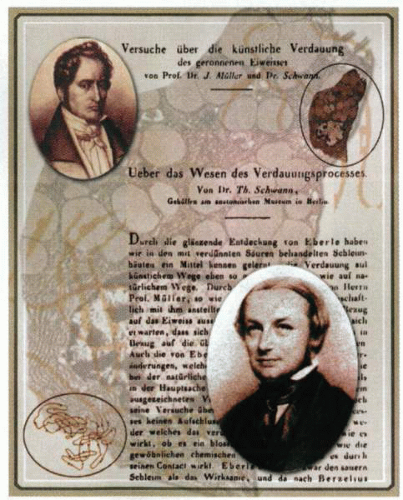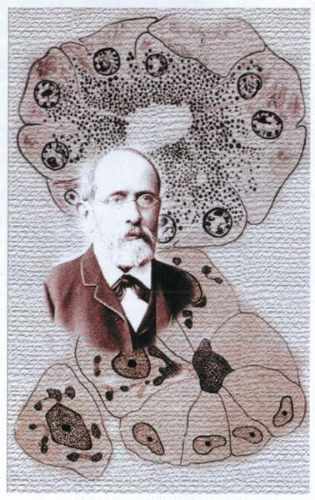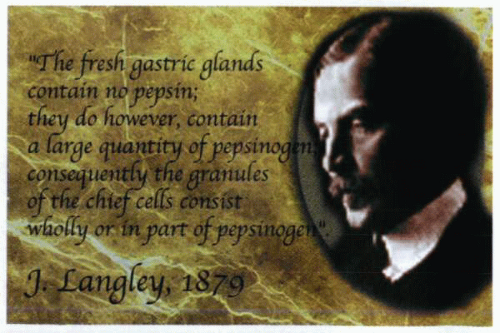Pepsin
History of pepsinogen
Pepsinogen is a potent digestive enzyme secreted by the chief cell of the gastric gland into the lumen of the stomach. This agent is likely to play a significant role in the pathogenesis of peptic ulcer disease. Although abnormalities in this protein have been epidemiologically linked to gastric carcinoma and its precursors, no specific pathogenic role exists for this potent enzyme.
The story of this poorly understood enzyme began in the Berlin laboratory of J. Müller, where, in 1836, Theodor Schwann described a water-soluble factor in gastric juice that digested egg white. He called it pepsin, after the Greek word for digestion.
Schwann had just obtained his MD degree and was continuing as an assistant in Müller’s laboratory. His investigation of gastric glands was initiated by the latter, who had asked him to attempt to subject the physiologic properties of either an organ or a tissue to physical measurement. Schwann initially developed a muscle balance and became the first to establish the basics of the tension-length diagram. Thereafter, while successfully measuring secretion from the gastric gland, he stumbled on a proteolytic enzyme whose properties he characterized and soon thereafter published.
Unfortunately for the science of the stomach, this observation became lost in the subsequent spate of diverse investigative work that emanated from the young man. He moved on to fermentation and was the first to demonstrate the importance of oxygen both for alcoholic fermentation in yeast and for putrefaction. His work with yeast led to probably his greatest discovery, which was the assertion of a common cellular basis for all living matter. However, his failure to win a chair at the University of Bonn appeared to have damaged his impetus for scientific investigation—his last useful digestive observation, which appeared 40 years before his death, was the necessity of bile for digestion (and for survival). He had modified a biliary fistula model for these experiments, which also happened to be the last physiologic experiments he would conduct.
Three years after the initial identification of pepsin by Schwann, Wasmann was able to isolate the protein and thereby establish the premise for protein digestion. In 1846, Claude Bernard wrote extensively on the digestive ferments of the pancreas, whereas the possibility of a proenzyme, pepsinogen, was formally postulated by Epstein and Grutzner in 1854. The first evaluation of the protein products of gastric digestion was described by Meisner in 1859. Heidenhain, while studying the pancreas, was soon thereafter able to describe the secretory mechanisms of proteolytic zymogens. Eight years into his tenure as Professor of Physiology at Breslau, Heidenhain began a systematic study of glands that would occupy him for almost the next 30 years. During this time, his experimental work suggested to him that all secretory phenomena were intracellular rather than mechanical processes. From these, he was able to draw some important conclusions about gastric physiology. First, he concluded that the secretion of saliva was an indicator of blood flow, and second, that there were two kinds of cells in gastric glands: those that secrete hydrochloric acid, which he named Belegzellen, and those that secrete pepsin, Hauptzellen. His histologic notes also describe a yellow-stained small cell situated adjacent to these cells that 100 years later would be identified as the endocrine ECL cell. His use of a surgical pouch for investigating acid physiology later became the standard model for such investigations.
Heidenhain’s observations were followed by those of Kühne, who theorized that because the stomach itself was not digested by pepsin, the gastric ferments must have inactive protein precursors (e.g., pepsinogen). It was Kühne who
developed the term zymogen for these precursors, as well as the term enzyme. He also identified the proteolytic pancreatic enzyme, trypsin, in 1868 and influenced the work of his later English admirers.
developed the term zymogen for these precursors, as well as the term enzyme. He also identified the proteolytic pancreatic enzyme, trypsin, in 1868 and influenced the work of his later English admirers.
However, it remained for Langley at Cambridge in the 1880s to formalize the study of pepsinogen and the mechanisms of its secretion. Langley’s introduction to the gastric gland was driven by chance. His mentor, the great physiologist Foster, suggested he study the effects of the drug jaborandi (pilocarpine) on the heart. These studies in 1874 led him toward studying its effects on secretion. After an initial prelude in the submaxillary gland, Langley dove into the regulation of secretion in the stomach, which he would pursue for the better part of the next 20 years.
Stay updated, free articles. Join our Telegram channel

Full access? Get Clinical Tree






